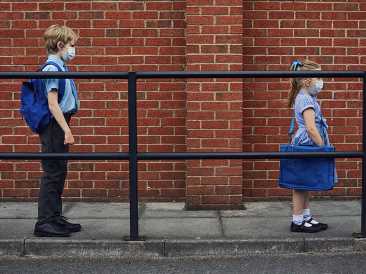Children not a major source of COVID-19, finds rapid review

A review of the roles of schools and daycare centers in the COVID-19 pandemic finds that children under the age of 10 are not a major source of the disease.

The impact of COVID-19 on children has been uncertain throughout the ongoing pandemic. While most relevant studies have found that children are less susceptible to the disease, others have suggested that they have a similar rate of infection to adults.
And although COVID-19 is generally a mild disease in children, there have been reports of a rare inflammatory syndrome occurring in children with COVID-19.
Uncertainty about the impact of the disease on children and about their ability to transmit the virus to others has caused confusion and led to concerns about the reopening of schools.
As the body of evidence grows, the National Collaborating Centre for Methods and Tools (NCCMT), in Ontario, Canada, have published a review to help clarify the roles that schools and daycare centers have in the transmission of COVID-19.
Stay informed with live updates on the current COVID-19 outbreak and visit our coronavirus hub for more advice on prevention and treatment.
The NCCMT conducts “rapid evidence reviews” of research to support public health in Canada, but their findings are widely applicable.
Their latest review found that children are not a major source of COVID-19 and are more likely to contract the disease from adults than from other children.
However, it is worth noting that other studies have found different results, particularly in light of recent developments at a summer camp in the state of Georgia.
While evidence of the transmission of SARS-CoV-2, the virus that causes COVID-19, among children is currently mixed, as more data emerge, they will have major implications for imminent plans to reopen schools in the United States.
Rapid review
The review included research published up to July 20, 2020, on the role of schools and daycares in SARS-CoV-2 transmission, including the likelihood of transmission between children and adults.
The researchers ultimately analyzed the results of 31 studies, including 15 single studies and 16 syntheses, or reviews. Evidence on the transmission of COVID-19 in daycares and schools was limited to case reports based on contact tracing and studies on the prevalence of the disease in these settings.
“We recognized early on that there was a significant need to summarize the overwhelming amount of research evidence emerging on COVID-19, appraise its quality, and distribute widely that evidence to support public health decision making in Canada.”
— Prof. Maureen Dobbins, scientific director of the NCCMT
The team found that the prevalence of COVID-19 was lower among children in daycares and schools than among adults working in these settings. However, they considered the quality of this evidence to be low.
Contact tracing studies suggest that the transmission of the disease by children in schools is very low.
For children who had the infection, the transmission was traced back to community settings, home settings, or adults, rather than other children from their schools or daycare centers.
Within households, adults were much more likely to be the index case — the first case, or “patient zero” — than children. The researchers considered the quality of this evidence to be moderate.
Children unlikely to transmit COVID-19
Overall, the studies published so far suggest that the likelihood of contracting and transmitting COVID-19 scales with age and that young children are unlikely to be a major source of transmission.
“The bottom line, thus far, is that children under 10 years of age are unlikely to drive outbreaks of COVID-19 in daycares and schools and that, to date, adults were much more likely to be the transmitter of infection than children,” explains assistant professor Sarah Neil-Sztramko, of the NCCMT and McMaster University’s Department of Health Research Methods, Evidence, and Impact.
Although the findings of the review were consistent, the authors say that a further review should be performed at a later date, in case the findings change.
The authors also warn that some of the studies included in the review have not yet been peer-reviewed. As a result, they advise caution when interpreting the findings.
Strain on families is high
The closure of schools and other childcare facilities due to COVID-19 has faced parents with new childcare commitments and put many families under significant strain.
An additional review carried out by the NCCMT investigated the impact of the pandemic on families in more detail.
It included 38 studies and explored the impact of the pandemic on employment, the division of labor in the household, and the wellbeing of parents and children.
The evidence suggests that the pandemic has placed a strain on families, and especially on female caregivers, who have experienced the greatest reduction in working hours due to the pandemic.
Among parents able to work from home, women, on average, reduced their working hours more than men, with mothers of primary school-aged children facing the biggest reductions.
“Families are under strain, especially female caregivers and children, with increasing gender gaps in employment and household labor and poor mental health outcomes in children,” says Professor Neil-Sztramko.
The review identified other gender gaps in employment as a result of the pandemic, with women more likely to experience both reduced hours and job losses.
Concerning the toll on the mental health of children, the authors found evidence of higher levels of anxiety among children during the pandemic and overall higher levels of anxiety among families with children than those without, due to concerns about the social isolation of children, for example.
For live updates on the latest developments regarding the novel coronavirus and COVID-19, click here.
Source: Read Full Article